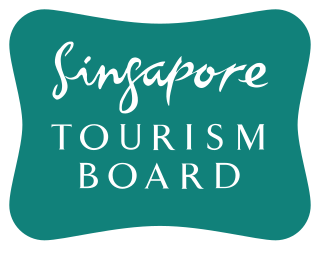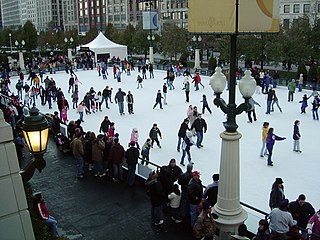
Tourism in Australia is an important part of the Australian economy, and comprises domestic and international visitors. Australia is the fortieth most visited country in the world according to the World Tourism Organization. In the financial year 2018/19, tourism was Australia's fourth-largest export and over the previous decade was growing faster than national GDP growth. At the time it represented 3.1% of Australia's GDP contributing A$60.8 billion to the national economy.

Tourism Malaysia or Malaysia Tourism Promotion Board (MTPB) is an agency under the Ministry of Tourism, Malaysia.

Tourism in the United Kingdom is a major industry and contributor to the U.K. economy, which is the world's 10th biggest tourist destination, with over 40.1 million visiting in 2019, contributing a total of £234 billion to the GDP.

The Singapore Tourism Board (STB) is a statutory board under the Ministry of Trade and Industry of the Government of Singapore, tasked to promote the country's tourism industry.
VisitScotland, formerly the Scottish Tourist Board, is a national tourism organisation for Scotland. It is an executive non-departmental public body of the Scottish Government, with offices in Edinburgh, Glasgow, Aberdeen, Inverness, and other parts of Scotland.

The Department of Tourism is the executive department of the Philippine government responsible for the regulation of the Philippine tourism industry and the promotion of the Philippines as a tourist destination.

Visit Wales is the Welsh Government's tourism organisation. Its aim is to promote Welsh tourism and assist the tourism industry.
Visit Philadelphia, formally known as the Greater Philadelphia Tourism Marketing Corporation (GPTMC), is a private, non-profit organization that promotes leisure travel to the five-county Philadelphia metropolitan area. It was founded in 1996 by the City of Philadelphia, the Commonwealth of Pennsylvania and The Pew Charitable Trusts. In 1998, House Bill 2858, Act 174 designated VISIT PHILADELPHIA, then GPTMC, to serve as the official Regional Attractions Marketing Agency.

Tourism in Chicago draws on the city's status as a "world-class destination known for its impressive architecture, first-rate museums, brilliant chefs" and wide variety of neighborhood attractions.
The European Travel Commission (ETC) is an association of National Tourism Organisations (NTOs) based in Brussels. It was created in 1948 to promote Europe as a tourist destination to long-haul markets outside of Europe, originally the US and later Canada, Latin America and Asia-Pacific. ETC currently has 33 member NTOs and 14 associate members from the private industry. The association aims to raise awareness of the importance of tourism among national European authorities and the general public through sharing best practices and cooperation in market intelligence and promotion.
The Oklahoma Department of Tourism and Recreation is a department of the government of Oklahoma within the Tourism and Branding Cabinet. The Department is responsible for regulating Oklahoma's tourism industry and for promoting Oklahoma as a tourist destination. It is the Department which established regional designations for the various parts of the state which are in common use today: Red Carpet Country, Green Country (Northeast), Frontier Country (Central), Choctaw Country (Southeast), Chickasaw Country, and Great Plains Country (Southwest).
The Maryland Department of Commerce is a government agency in the state of Maryland in the United States. Although it was originally founded in 1884, the department came to be recognized as the Department of Commerce in 2015.
Tourism and Events Queensland (TEQ) is the Queensland Government's lead marketing, experience development and major events agency, representing the state's tourism and events industries.
The Norfolk Convention and Visitors Bureau is the official tourism promotion agency for the city of Norfolk, Virginia and a travel and visitor resource for information on hotels, packages, attractions, events and things to do. VisitNorfolk is a private 501 (c) (6) organization located in Downtown Norfolk at 232 E. Main Street, Norfolk, Virginia 23510. VisitNorfolk's objective is to generate economic growth for Norfolk by producing high volumes of visitors, tax revenues and travel related jobs. The organization expands the role of travel and tourism in the Norfolk economy via sales, marketing and customer service.
Tourism Improvement Districts (TIDs) are a type of business improvement district in the United States. The aim of TIDs is increasing the number of overnight visitors using business and services in that area. TIDs are formed through a public–private partnership between the local government and the businesses in a district. TID funds are usually managed by a nonprofit corporation, generally a Convention and Visitors' Bureau, hotel association, or similar destination marketing organization. Typical TID services include marketing programs to raise awareness of the destination, sponsorship of special events that attract overnight visitors, and sales programs to bring in large-group business. Synonymous terms for TIDs include: tourism marketing district, hotel improvement district, and tourism business improvement district.
The Seychelles Tourism Board (STB), a public/private sector body headed by CEO Mrs. Sherin Francis, with Mrs. Kathleen Mason as Chairperson, oversees most aspects of Seychelles' tourism industry whose Minister is Mr. Didier Dogley. The Seychelles Tourism Board is responsible for the promotion and marketing of the Seychelles islands as the preferred tourist destination.
The Utah Office of Tourism is a government agency which aims to increase tourism to the state of Utah. This increase would provide revenue to Utah, easing the burden on taxpayers.
Fashion tourism is a niche market segment evolved out of three major sectors: Creative Tourism, Cultural Tourism and Shopping Tourism. Fashion Tourism can be defined as “the interaction between Destination Marketing Organizations (DMOs), trade associations, tourism suppliers and host communities, with people travelling to and visiting a particular place for business or leisure to enjoy, experiment, discover, study, trade, communicate about and consume fashion.”
The Namibia Tourism Board (NTB) is mandated by the Namibian Government as the regulatory and marketing body for tourism activities in Namibia, and is headquartered in Windhoek, Namibia.
Thessaloniki Convention & Visitors Bureau—known as TCVB —was the first such bureau that operated in Greece. It was founded by the Thessaloniki Hotel Association (THA) in 2000, operated as a non‑profit organization and was active until 2009. The main goal of TCVB was to establish the city of Thessaloniki as an internationally recognized conference city and a popular destination for incentive travel.






